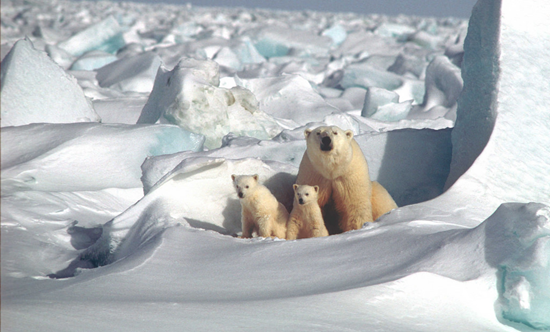
Whether it's due to habitat loss, poaching or unintended poisonings, animals like the cheetah are seeing their populations drop lower and lower. Conservation efforts, including protected reserves and bans on hunting and poaching, may be too little too late to stop the downward spiral many animals are experiencing. These 10 animals in particular once had the the run of the wilderness, but now they're on the brink of disappearing.
1. Polar bears
The polar bear has become the poster animal for the devastating changes global warming is bringing to the Arctic. Polar bears are dying because their range is shrinking; the sea ice they use to hunt seals is melting as temperatures rise. With a recognized 19 subpopulations in decline, the International Union for Conservation of Nature (IUCN) estimates that there fewer than 26,000 polar bears worldwide.
A new study paints an even more dire picture. Researchers led by Eric Regehr of the U.S. Fish and Wildlife Service in Anchorage, Alaska, combined 35 years of satellite data on Arctic sea ice with shifts in polar bears groupings across four Arctic zones. They found that there's a 70 percent chance the polar bear population will decline by more than 30 percent by the middle of this century.
2. Orangutans
About 2,070 to 3,070 orangutans live on the Southeast Asian islands of Borneo and Sumatra. Their habitat has been chopped up into smaller, more isolated pockets. Logging, road construction and especially the creation of palm-oil plantations have leveled their habitats, leaving them vulnerable to hunting and kidnapping (to be sold as pets). Like mountain gorillas, orangutans have the benefit of good PR, but that might not be enough as one conservation charity has declared that the orangutan could be extinct within 10 years if more is not done to preserve their habitats.
3. African lions
It might be too late for lions. The panthera leo has experience a population reduction of 43 percent between 1993 and 2014. As a result, today there are an estimated 23,000 to 39,000 lions in the wild. Their population has been carved up into ever-tightening, isolated ranges, and as the IUCN notes, humans are spreading into these small pockets of space and instability within Africa isn't conducive to conservation efforts.
4. Elephants
There are about 470,000 African elephants in the wild. Habitat fragmentation as a result of human land use aggravates elephant populations. Meanwhile, Poachers hunt elephants for their tusks, a relationship that has changed their evolutionary path - elephants with shorter tusks are breeding more and producing offspring with increasingly stunted tusks. Meanwhile, Elephants don't breed until they're teenagers and gestation lasts for 22 months - creating a population that struggles to bounce back.
5. Tigers
Tigers and humans don't mix well. We hunt them for fur, gallbladders, paws, teeth and tail. Their habitat has been under assault by development over the past few decades. All six remaining subspecies are endangered, and the IUCN puts the the overall Panthera tigris population between 2,154 and 3,159 big cats.
6. Cheetahs
Do you recognize any patterns? We're good at killing big cats. Cheetahs are fast, but they might not be able to outrun extinction. The cat that can accelerate faster than a muscle car isn't adaptable to habitat change and has recently suffered from genetic degradation due to inbreeding. It's estimated that about 6,676 cheetahs remain the wild. They have a high infant mortality rate and are losing more habitat every year.
7. Egyptian vultures
These beautiful, white, well-feathered birds have an average wing span of 5.5 feet and are found in southern Europe, northern Africa and western and southern Asia. They use tools, dropping rocks onto ostrich eggs to crack the shell. Their thin beaks and long necks let them get carrion larger birds can't reach. These crafty birds face a declining population across all of its regions, with between 13,000 and 41,000 birds in the wild. A surprising source of danger for the birds is Diclofenac, an anti-inflammatory drug used on domesticated animals.
8. Eastern gorillas
Both species of the mountain gorilla - the eastern lowland gorilla (Gorilla beringei graueri) and the mountain gorilla (Gorilla beringei beringei) - face significant challenges in their isolated habitats. The mountain gorilla has around 680 individual members living between two different groups and both face threat from an ever-encroaching human population. The eastern lowland gorilla, dealing with war and strife in the Democratic Republic of Congo, has seen its population drop from 17,000 in 1995 to 3,380 in 2016.
9. Chinese alligators
While American alligator populations are exploding, their Asian cousins are in danger. There are possibly only 50 Chinese alligators living in the wild in a handful of ponds along the lower Yangtze River in eastern China. They were pushed out of their habitats by agriculture and the presence of poisoned rats, which the alligators eat. The species is thriving in captivity, with over 10,000 around the world.
10. Blue whales
The world's largest animal is in trouble. Blue whales were nearly hunted to extinction in the early 20th century, and by the time hunting was deemed illegal in 1966, only a few thousand remained, down from a pre-whaling population of about 240,000. Today, the population has rebounded to between 10,000 and 25,000 individuals. They remain are under attack from seas polluted by chemicals such as PCBs and noise from boats and sonar equipment. Add the warming and acidification of the seas, and the outlook is bleak.










No comments:
Post a Comment
Please adhere to proper blog etiquette when posting your comments. This blog owner will exercise his absolution discretion in allowing or rejecting any comments that are deemed seditious, defamatory, libelous, racist, vulgar, insulting, and other remarks that exhibit similar characteristics. If you insist on using anonymous comments, please write your name or other IDs at the end of your message.